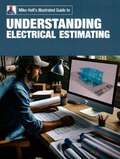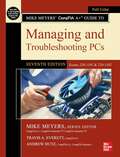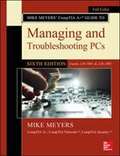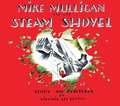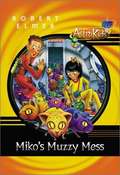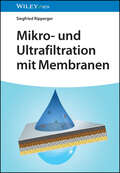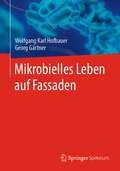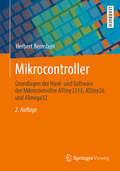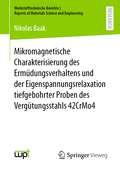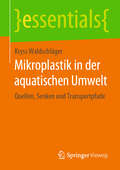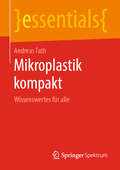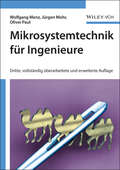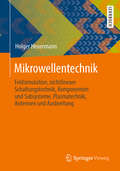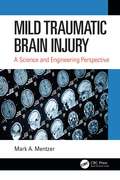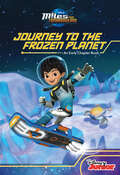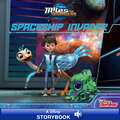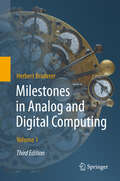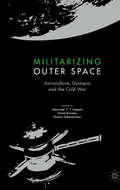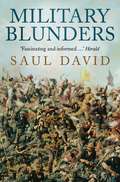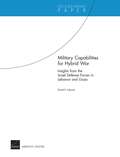- Table View
- List View
Mike Holt's Illustrated Guide to Understanding Electrical Estimating
by Mike HoltAll businesses exist for one reason, and that is to make money! One important step is to know what it costs to complete your projects. How you estimate can make or break a company. With practice, you can learn the skills and techniques that will allow you to produce a high-quality estimate in a timely manner that will allow your company to accurately predict material and labor needs so you can successfully and consistently manage your project for a profit! While today most people use electrical estimating software to create estimates, you need to understand the numbers and the process behind the estimate if you want to stay in business. This book teaches you the estimating process so you can understand what estimating is and how to do it right. Armed with the right information, you will know how to be competitive, make more money, and, more importantly, when to say “No” and walk away! In this program you'll learn: • Introduction to Estimating • Qualities of an Estimator • The Estimating Process • The Takeoff • Determining Labor Costs • Unit Pricing • Determining Break-Even Cost • The Bid Process • Software-based Estimating
Mike Meyers' CompTIA A+ Guide to Managing and Troubleshooting PCs: (Exams 220-1101 & 220-1102)
by Mike Meyers Travis A. Everett Andrew HutzFully Updated, Essential Skills for a Successful IT Career. <p><p>Created and edited by the leading authority on CompTIA A+ certification and training, this four-color guide will help you pass CompTIA A+ exams 220-1101 and 220-1102 and become a certified IT professional with proven expertise in hardware and software. Mike Meyers’ CompTIA A+™ Guide to Managing and Troubleshooting PCs, Seventh Edition offers complete coverage of the latest exam objectives. You’ll get on-the-job tips, end-of-chapter review questions, and hundreds of photographs and illustrations.
Mike Meyers' Comptia A+ Guide To Managing And Troubleshooting PCs ): (exams 220-1001 & 220-1002
by Mike MeyersFully Updated, Essential Skills for a Successful IT Career. Written by the leading authority on CompTIA A+ certification and training, this four-color guide will help you pass CompTIA A+ exams 220-1001 and 220-1002 and become a certified IT professional with proven expertise in hardware and software. Mike Meyers’ CompTIA A+® Guide to Managing and Troubleshooting PCs, Sixth Edition offers complete coverage of the latest exam objectives. You’ll get on-the-job tips, end-of-chapter review questions, and hundreds of photographs and illustrations. Learn how to: •Work with CPUs, RAM, BIOS, motherboards, power supplies, and other personal computer components•Install, configure, and maintain hard drives•Manage input devices and removable media•Set up, upgrade, and maintain all versions of Windows•Troubleshoot and fix computer problems•Establish users and groups•Set up video and multimedia cards•Administer smartphones, tablets, and other mobile devices•Set up wired and wireless networks•Connect to the Internet•Protect your personal computer and your network•Install printers and other peripherals•Implement virtualization and cloud-based technologies•Understand safety and environmental issues.
Mike Mulligan and His Steam Shovel
by Virginia Lee BurtonMike and his trusty steam shovel, Mary Anne, have a very important job. They dig deep canals for boats to travel through, cut mountain passes for trains, and hollow out cellars for big city skyscrapers- the very symbol of modern industrial America. But with progress comes new machines, and soon the inseparable duo are out of work. Mike believes that Mary Anne can dig as much in a day as a hundred men can dig in a week, and the two have one last chance to prove it and save Mary Anne from the scrap heap. What happens next in the small town of Popperville is a testament to their friendship, as well as old-fashioned hard work and ingenuity.
Mike Mulligan and His Steam Shovel
by Virginia Lee BurtonMike and his trusty steam shovel, Mary Anne, dig deep canals for boats to travel through, cut mountain passes for trains, and hollow out cellars for city skyscrapers -- the very symbol of industrial America. But with progress come new machines, and soon the inseparable duo are out of work. Mike believes that Mary Anne can dig as much in a day as one hundred men can dig in a week, and the two have one last chance to prove it and save Mary Anne from the scrap heap. What happens next in the small town of Popperville is a testament to their friendship, and to old-fashioned hard work and ingenuity.
Miko's Muzzy Mess (AstroKids #4)
by Robert ElmerWELCOME TO 2175! Meet the Astrokids--Miko, Buzz, Mir, DeeBee, and Tag--five friends learning biblical truth through out-of-this-world adventures aboard space station CLEO-7. Everyone thought I was the only stowaway on CLEO-7--until we found two muzzies hiding in the walls of the station. So cuddly and cute! What was to worry about? But with just a nibble of my chocolate bar, things got out of hand. Before long, the station was crawling with thousands of hungry muzzies. Yikes! And it was all my fault! Could we AstroKids catch all the muzzy invaders, or was this good-bye CLEO-7?
Mikro- und Ultrafiltration mit Membranen
by Siegfried RippergerMikro- und Ultrafiltration mit Membranen Klar strukturiert und kompakt wird hier die Mikro- und Ultrafiltration mit Membranen behandelt, von den Grundlagen und Charakterisierung von Membranen bis hin zu industriellen Anwendungen und Instandhaltung Die Mikro- und Ultrafiltration mit Membranen ist eine verbreitete und etablierte Schlüsseltechnologie für die Aufbereitung von Stoffströmen. Im Buch werden sowohl die Grundlagen der Mikro- und Ultrafiltration mit Membranen, Herstellung und Charakterisierung, Filtrationsverfahren, industrielle Anwendungen als auch die Instandhaltung und Reinigung von Membranen behandelt. Prinzipien und praktische Anwendungen werden klar strukturiert dem Leser zugänglich gemacht Behandelt alle Prozesse von Grundlagen bis zu den Anwendungen Unverzichtbar für die Ausarbeitung, Etablierung und Instandhaltung von Membrantrennverfahren Es bietet eine umfassende Einführung in die Theorie und Praxis der Membranfiltration und gibt wertvolle Einblicke in die verschiedenen Anwendungen und Technologien. Ob Sie nun ein erfahrener Ingenieur sind oder gerade erst in die Welt der Membranfiltration eintauchen, dieses Buch wird Ihnen helfen, Ihre Kenntnisse zu vertiefen und Ihre Fähigkeiten zu verbessern. Mit klaren Erklärungen, anschaulichen Beispielen und praktischen Tipps ist es ein unverzichtbares Nachschlagewerk für jeden, der sich mit der Filtration von Flüssigkeiten beschäftigt.
Mikrobielles Leben auf Fassaden
by Georg Gärtner Wolfgang Karl HofbauerArchitekten, Bauingenieure, Bausachverständige und andere Fachleute sowie Bauherren, Wissenschaftler und Masterstudenten finden in diesem Buch alle Informationen zu Fassadenalgen und -pilzen. Es gibt einen detaillierten Überblick über die Mikroorganismen, die das anfängliche Wachstum an den Außenfassaden von Gebäuden bilden und befasst sich mit den ökophysiologischen Eigenschaften, die die Rahmenbedingungen charakterisieren, unter denen diese Mikroorganismen an Fassaden auftreten können. Neben einem Bestimmungsschlüssel für die charakteristischen Anflüge an Fassaden von Mikroorganismen enthält dieses Buch eine ausführliche Beschreibung der einzelnen Organismen unter Angabe ihres ökologischen Verbreitungsgebiets. Darüber hinaus werden die verschiedenen ökologischen Parameter in kurzen Kapiteln diskutiert. Auch Maßnahmen zur Vorbeugung und Bekämpfung der Besiedelung von Fassaden mit Mikroorganismen werden thematisiert.
Mikrocontroller: Grundlagen der Hard- und Software der Mikrocontroller ATtiny2313, ATtiny26 und ATmega32
by Herbert BernsteinDie Mikrocontroller ATtiny2313, ATtiny26 und ATmega32 von Atmel sind im Unterricht und in der Praxis für ihre vielseitigen Anwendungen und einfache Programmierbarkeit bekannt. Der ATtiny2313 ist ein reiner digitaler Prozessor und mit diesem lernt man das Grundprinzip, erklärt anhand von einfachen Beispielen. Auch die Programmierung in Assembler wird an Beispielen ausführlich behandelt. Der ATtiny26 ist ein Prozessor mit internen AD-Wandlern an den Eingängen und DA-Wandlern an den Ausgängen. Beispiele für die Programmierung in Assembler runden das Prinzip ab. Der ATmega32 in seinem 40-poligen DIL-Gehäuse bildet die Lösung für einen kleinen Computer mit LCD-Anzeige und zahlreichen Peripheriebausteinen. Das besondere für die Programmierung in Assembler ist der kompatible Befehlssatz für die drei Mikrocontroller. Die 2. Auflage enthält neue Unterkapitel zu den Themen Schrittmotorenansteuerung mittels Mikrocontroller und programmierbarer autonomer Roboter.
Mikromagnetische Charakterisierung des Ermüdungsverhaltens und der Eigenspannungsrelaxation tiefgebohrter Proben des Vergütungsstahls 42CrMo4 (Werkstofftechnische Berichte │ Reports of Materials Science and Engineering)
by Nikolas BaakNikolas Baak befasst sich mit der Qualifizierung mikromagnetischer Methoden zur Bewertung der durch Tiefbohren erzeugten Randzonen hinsichtlich ihrer Oberflächenintegrität und deren Einfluss auf das Ermüdungsverhalten. Dabei wird das Ziel verfolgt, durch den Bohrprozess einen vorteilhaften Eigenspannungszustand zu erreichen. Beim hier eingesetzten Einlippen-Tiefbohren kommt es aufgrund des asymmetrischen Werkzeugaufbaus zu einer Art Festwalzprozess. Dadurch werden sowohl sehr hohe Oberflächengüten, als auch der gewünschte Druckeigenspannungszustand erzeugt. Da die meisten Verfahren zur Bestimmung der Oberflächenintegrität entweder zerstörend sind oder auch einen freien Zugang zur Oberfläche benötigen, werden hier zerstörungsfreie Prüfverfahren dafür ertüchtigt, die Oberflächenintegrität sowie den Ermüdungszustand der Bauteile zu bestimmen. Für beide hier betrachteten mikromagnetischen Verfahren, einerseits die Barkhausenrauschen-Analyse und andererseits die Wirbelstromprüfung, werden speziell angefertigte Sensoren, welche das Messsignal an der Innenseite der Bohrung detektieren können, verwendet. Die Messdaten der mikromagnetischen Verfahren werden mit den etablierten Verfahren zur Bestimmung der Oberflächenintegrität, wie bspw. Röntgendiffraktometrie, korreliert.
Mikroplastik in der aquatischen Umwelt: Quellen, Senken und Transportpfade (essentials)
by Kryss WaldschlägerMikroplastik ist derzeit ein allgegenwärtiges Thema in den Medien und wird daher auch in der Bevölkerung als umweltrelevante Problematik wahrgenommen. Da jedoch viel Halbwissen zur Meinungsbildung beiträgt, bereitet dieses essential den aktuellen Forschungstand auf und stellt ihn allgemein verständlich dar. Angefangen bei den Grundlagen der Mikroplastikdefinition und den derzeit bekannten Quellen über bisher nachgewiesene Konzentrationen in der aquatischen Umwelt bis hin zu den Senken wird der Weg des Mikroplastiks durch die Gewässer dieser Erde beschrieben. Abschließend wird auf die Umweltrisiken, die Mikroplastik für die Ökosysteme, die aquatischen Organismen und den Menschen birgt, eingegangen. Dabei werden viele Wissenslücken aufgezeigt, die zukünftig geschlossen werden müssen und die innerhalb der üblicherweise kurzen Beiträge in Massenmedien so nicht präsentiert werden.Die Autorin: Kryss Waldschläger hat Bauingenieurwesen studiert und arbeitet derzeit als wissenschaftliche Mitarbeiterin am Institut für Wasserbau und Wasserwirtschaft der RWTH Aachen University. Dort untersucht sie im Rahmen ihrer Promotion das Transportverhalten von Mikroplastik in Fließgewässern.
Mikroplastik kompakt: Wissenswertes für alle (essentials)
by Andreas FathWerden wir in den kommenden Jahren in unserem eigenen Plastikmüll ersticken? Oder schaffen wir es, noch rechtzeitig die Kurve zu kriegen? Die stetig wachsende Plastikmüllmenge ist problematisch für die Umwelt und den Mensch, der den Plastikmüll in Form von Mikroplastik aufnimmt. Der Autor Andreas Fath erklärt wissenschaftlich fundiert, aber allgemein verständlich, was Mikroplastik ist, wo es herkommt und welche Gefahren damit verbunden sind.
Mikrosystemtechnik für Ingenieure
by Wolfgang Menz Oliver PaulDie dritte Auflage des mittlerweile zum Standardwerk gereiften Lehrbuchs trägt den rasanten Entwicklungen in diesem interdisziplinären Gebiet umfassend Rechnung. Insbesondere die Kapitel Siliziumtechnik, Materialien und Alternative Technologien wurden stark erweitert. Außerdem sind neue Anwendungsaspekte hinzugekommen. Somit schlägt dieses Lehrbuch weiterhin in einzigartiger Weise den Bogen von den Grundlagen der Mikrosystemtechnik bis hin zu den aktuellen Anwendungen in einer Vielzahl von High-Tech Entwicklungen.
Mikrowellentechnik: Feldsimulation, nichtlineare Schaltungstechnik, Komponenten und Subsysteme, Plasmatechnik, Antennen und Ausbreitung
by Holger HeuermannDas Buch behandelt die verschiedenen numerischen Feldsimulationsverfahren, nichtlineare Schaltungstechnik und deren S- und X-Parameter sowie modernste Leistungsverstärkertechniken. Weiterhin werden neuartig dargestellte Oszillatoren und das große neue Feld der GHz-Plasmatechnik beschrieben. Darüber hinaus deckt es mit den Themen Hohlleiter, Mischer, Phasenregelkreise, Antennen und Ausbreitungseffekte in Kombination mit dem Bachelor-Buch „Hochfrequenztechnik“ alle Aspekte ab, die den aktuellen Stand der GHz-Technik betreffen.Die in diesem Lehrbuch vorgestellte Mikrowellenelektronik und -technik fasst somit die moderne Technik der elektromagnetischen sowie nichtlinearen Grundlagen, die im ein- und zweistelligen GHz-Bereich für Funk-, Navigations-, Lokalisierungs-, Mess-, Heiz- und sonstige Systeme benötigt werden, zusammen.
Mikrowellentechnik: Feldsimulation, nichtlineare Schaltungstechnik, Komponenten und Subsysteme, Plasmatechnik, Antennen und Ausbreitung
by Holger HeuermannDas Buch behandelt die verschiedenen numerischen Feldsimulationsverfahren, nichtlineare Schaltungstechnik und deren S- und X-Parameter sowie modernste Leistungsverstärkertechniken. Weiterhin werden neuartig dargestellte Oszillatoren und das große neue Feld der GHz-Plasmatechnik beschrieben. Darüber hinaus deckt es mit den Themen Hohlleiter, Mischer, Phasenregelkreise, Antennen und Ausbreitungseffekte in Kombination mit dem Bachelor-Buch „Hochfrequenztechnik“ alle Aspekte ab, die den aktuellen Stand der GHz-Technik betreffen.Die in diesem Lehrbuch vorgestellte Mikrowellenelektronik und -technik fasst somit die moderne Technik der elektromagnetischen sowie nichtlinearen Grundlagen, die im ein- und zweistelligen GHz-Bereich für Funk-, Navigations-, Lokalisierungs-, Mess-, Heiz- und sonstige Systeme benötigt werden, zusammen.
Mild Traumatic Brain Injury: A Science and Engineering Perspective
by Mark A. MentzerMild traumatic brain injury (mTBI), directly related to chronic traumatic encephalopathy, presents a crisis in contact sports, the military, and public health. Mild Traumatic Brain Injury: A Science and Engineering Perspective reviews current understanding of mTBI, methods of diagnosis, treatment, policy concerns, and emerging technologies. It details the neurophysiology and epidemiology of brain injuries by presenting disease models and descriptions of nucleating events, characterizes sensors, imagers, and related diagnostic measures used for evaluating and identifying brain injuries, and relates emerging bioinformatics analysis with mTBI markers. The book goes on to discuss issues with sports medicine and military issues; covers therapeutic strategies, surgeries, and future developments; and finally addresses drug trials and candidates for therapy. The broad coverage and accessible discussions will appeal to professionals in diverse fields related to mTBI, students of neurology, medicine, and biology, as well as policy makers and lay persons interested in this hot topic. Features Summarizes the entire scope of the field of mTBI Details the neurophysiology, epidemiology, and presents disease models and descriptions of nucleating events Characterizes sensors, imagers, and related diagnostic measures and relates emerging bioinformatics analysis with mTBI markers Discusses issues with sports medicine and military issues Covers therapeutic strategies, surgeries, and future developments and addresses drug trials and candidates Dr Mark Mentzer earned his PhD in Electrical Engineering from the University of Delaware. He is a former research scientist at the US Army Research Laboratory where he studied mild traumatic brain injury and developed early-detection brain injury helmet sensors. He is a certified test director and contracting officer representative. He possesses two Level-III Defense Acquisition University Certifications in Science and Technology Management and in Test and Evaluation. During his career, he developed a wide range of sensors and instrumentation as well as biochemical processes to assess brain trauma. Mentzer currently teaches graduate systems engineering and computer science courses at the University of Maryland University College.
Miles From Tomorrowland: Journey to the Frozen Planet
by Disney Book GroupMiles goes on a mission to retrieve a frozen rover on an ice-covered exoplanet. Suddenly, his sister, Loretta, slips and gets swept away down the river. It's up to Miles to save her in this far-out, fast-paced early chapter book filled with super-stellar illustrations!
Miles From Tomorrowland: Spaceship Invader
by Disney Book GroupRead along with Disney! While on a mission, Miles discovers what seems to be a cool fuzzy rock. But when chaos breaks out on the Stellosphere, Miles realizes that his discovery may not be a rock after all! Help Miles solve the mystery in this blastastic storybook with word for word narration!
Milestones in Analog and Digital Computing
by Herbert BrudererThis Third Edition is the first English-language edition of the award-winning Meilensteine der Rechentechnik; illustrated in full color throughout in two volumes. The Third Edition is devoted to both analog and digital computing devices, as well as the world's most magnificient historical automatons and select scientific instruments (employed in astronomy, surveying, time measurement, etc.). It also features detailed instructions for analog and digital mechanical calculating machines and instruments, and is the only such historical book with comprehensive technical glossaries of terms not found in print or in online dictionaries. The book also includes a very extensive bibliography based on the literature of numerous countries around the world.Meticulously researched, the author conducted a worldwide survey of science, technology and art museums with their main holdings of analog and digital calculating and computing machines and devices, historical automatons and selected scientific instruments in order to describe a broad range of masterful technical achievements. Also covering the history of mathematics and computer science, this work documents the cultural heritage of technology as well.
Militarizing Outer Space: Astroculture, Dystopia and the Cold War (Palgrave Studies in the History of Science and Technology)
by Alexander C. T. Geppert Daniel Brandau Tilmann SiebeneichnerMilitarizing Outer Space explores the dystopian and destructive dimensions of the Space Age and challenges conventional narratives of a bipolar Cold War rivalry. Concentrating on weapons, warfare and violence, this provocative volume examines real and imagined endeavors of arming the skies and conquering the heavens. The third and final volume in the groundbreaking European Astroculture trilogy, Militarizing Outer Space zooms in on the interplay between security, technopolitics and knowledge from the 1920s through the 1980s. Often hailed as the site of heavenly utopias and otherworldly salvation, outer space transformed from a promised sanctuary to a present threat, where the battles of the future were to be waged. Astroculture proved instrumental in fathoming forms and functions of warfare’s futures past, both on earth and in space. The allure of dominating outer space, the book shows, was neither limited to the early twenty-first century nor to current American space force rhetorics.
Military Adaptation in War
by Williamson MurrayMilitary Adaptation in War addresses one of the most persistent, yet rarely examined, problems that military organizations confront: namely, the problem of how to adapt under the trying, terrifying conditions of war. This work builds on the volume that Professor Williamson Murray edited with Allan Millett on military innovation (a quite different problem, though similar in some respects). In Clausewitzian terms, war is a contest, an interactive duel, which is of indeterminate length and presents a series of intractable problems at every level, from policy and strategy down to the tactical. Moreover, the fact that the enemy is adapting at the same time presents military organizations with an ever-changing set of conundrums that offer up no easy solutions. As the British general, James Wolfe, suggested before Quebec: "War is an option of difficulties. " Dr. Murray provides an in-depth analysis of the problems that military forces confront in adapting to these difficulties.
Military Blunders: The How And Why Of Military Failure
by Saul DavidRetelling the most spectacular cock-ups in military history, this graphic account has a great deal to say about the psychology of military incompetence and the reasons even the most well-oiled military machines inflict disaster upon themselves. Beginning in AD9 with the massacre of Varus and his legions in the Black Forest all the way up to present day conflict in Afghanistan it analyses why things go wrong on the battlefield and who is to blame.
Military Blunders: The How And Why Of Military Failure
by Saul DavidRetelling the most spectacular cock-ups in military history, this graphic account has a great deal to say about the psychology of military incompetence and the reasons even the most well-oiled military machines inflict disaster upon themselves. Beginning in AD9 with the massacre of Varus and his legions in the Black Forest all the way up to present day conflict in Afghanistan it analyses why things go wrong on the battlefield and who is to blame.
Military Capabilities for Hybrid War: Insights from the Israel Defense Forces in Lebanon and Gaza
by David E. JohnsonThe Israel Defense Forces have gained much experience against hybrid opponents--Hezbollah and Hamas--in recent conflicts in Lebanon and Gaza. The lessons from these experiences are relevant to understanding the capabilities the U.S. Army and the joint force will require in the future. Principal findings highlight the importance of combined arms fire and maneuver; precision, standoff fires; responsive air and artillery support; and heavy forces.
Military Enlistment of Hispanic Youth: Obstacles and Opportunities
by Beth J. Asch Jacob Alex Klerman David S. Loughran Meredith Kleykamp Christopher BuckAlthough polls of Hispanic youth show a strong propensity to serve in the military, Hispanics are nonetheless underrepresented among military recruits. The authors discuss the major characteristics that disproportionately disqualify Hispanic youth and explore actions that could be taken to increase Hispanic enlistments.
